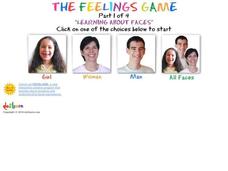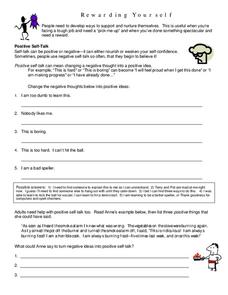Do2Learn
Social Play Action Figures
Three activities stem from one hands-on project designed to explore character traits. Scholars create an action figure that reflects their personality to teach others about themselves and role play conversational skills.
Do2Learn
Emotions Color Wheel
Support emotional development with a color wheel featuring a variety of feelings. Each expression comes equipped with an informative pop-up offering a picture, its etymology, a definition, and an example statement.
Do2Learn
Feelings Chart
Some days are better than others. Help autistic learners and other members of your class who have difficulty expressing their emotions with a feelings chart that presents a smiling face, a less smiling face, a neutral face, an unhappy...
Do2Learn
The Feelings Game
Discerning emotions and intent from facial expressions can be difficult for many learners, particular those with autism spectrum disorder. Help class members practice reading faces with an interactive resource that features three...
Keep Your Children Safe
Hurt Tracker Math
Boost emotional intelligence and division skills with a three-question worksheet featuring two imaginary towns that record when citizens hurt, forgive, or punish one another. Using division, scholars calculate each problem to decide...
Keep Your Children Safe
Fleeting Happiness
Shed light onto the subject of happiness with a activity that focuses on how the emotion—much like other emotions—does not last forever. Scholars read brief passages and answer nine short-answer questions that examine their personal...
Keep Your Children Safe
What Is Happiness
Explore the feeling of happiness with a worksheet created to boost emotional intelligence. Scholars detail what makes them happy then draw a happy face.
Keep Your Children Safe
What Makes Me Afraid
Encourage scholars to be brave about feeling afraid with instructional activity designed to enhance emotional intelligence. Learners share what makes them feel afraid then draw a face that appears scared.
Keep Your Children Safe
What is Sadness
Encourage emotional intelligence with a worksheet examining the feeling of sadness. Scholars answer the question, "What makes you sad?" and draw a what their face looks like when they are sad.
Keep Your Children Safe
What Is Anger
Enhance emotional intelligence with a activity that allows scholars to explore the feeling of anger. Learners detail what makes them feel angry and draw an angry face.
International Boys' Schools Coalition
Empathy
Putting yourself in someone else's shoes is a common phrase we hear from time to time, but do children really understand? Explore empathy with elementary schoolers using these activities. Focusing on feelings and emotions,...
Talking with Trees
Empathy
Strengthen the skill to empathize with others with a worksheet that challenges scholars to match emotions—including happy, confused, sad—to one's body language.
Museum of Tolerance
Music Evokes Memories and Emotions
Dim the lights, take a deep breath, and press play to explore the emotions and memories that music elicits. Class members begin using relaxation techniques designed to create a positive listening experience. As music plays, learners...
Pearson Longman
Emotions Reading
Explore the many types of feelings and how people express them with a lesson compiled of kid-friendly activities that spark critical thinking, self-reflection, and reinforce language and writing skills. Scholars delve into the variety of...
Project B.A.S.I.C. Child Development Specialist and Child Care Consultation
Better Attitudes and Skills in Children
Little kids often have very big feelings, and need help expressing them. A set of social emotional lessons provide tangible ways for young elementary learners to visualize their emotions, focus on clear communication, and channel their...
Council for the Curriculum, Examinations and Assessment
Feelings and Emotions
The focus of the second in a 10-session course on Social, Physical, Emotional, Cognitive and Spiritual (SPECS) health is on learning to express and manage feelings appropriately. Class members learn different ways of...
Council for the Curriculum, Examinations and Assessment
Feelings and Emotions
Eighth graders express their emotions with a set of activities about self reflection and feelings. With a set of emotion cards and a worksheet that details negative thought patterns, the resource empowers young learners to discover and...
Peaceful Solution Character Education
Self-Control Starts With You
How can negative thoughts affect your life? Learn about the ways you think about yourself can define your personality, and how self control can be the answer to higher self esteem.
Conflict Resolution Network
Empathy
Children are naturally friendly and communicative, but often have a hard time expressing their emotions in a clear and understandable way. Help them hone their communication skills with a set of activities based on creating empathy,...
Edutopia
Empathy
Teach your learners about support, respect, and listening skills with an activity about empathy. Class members set goals for themselves regarding their peer relationships, and monitor their own progress over a period of time.
Northern Ireland Curriculum
Feeling Good, Feeling Sad
Fill your classroom with grand conversations about emotions and the healthy ways to express them. Your scholars will create a collage, play a feelings game, read stories, and reflect on their daily feelings.
University of Washington
Rewarding Yourself
Everyone experiences negative self-talk from time to time, but how can youngsters learn to take it easy on themselves? Use an activity that focuses on talking positively to oneself, including giving yourself compliments and spending...
ESL Kid Stuff
Feelings & Emotions
Sometimes it can be hard to express emotions. Help little learners figure out what makes them happy, angry, sad, or scared with a lesson that focuses on feelings. It includes singing, drawing, matching flashcards, and more.
PBS
Robot Body Language
How can you tell what someone is feeling when they aren't saying a word? Explore non-verbal communication with an activity based on Cynthia Breazeal's work with expressive robots. One learner puts a bag over his or her face and uses body...

























